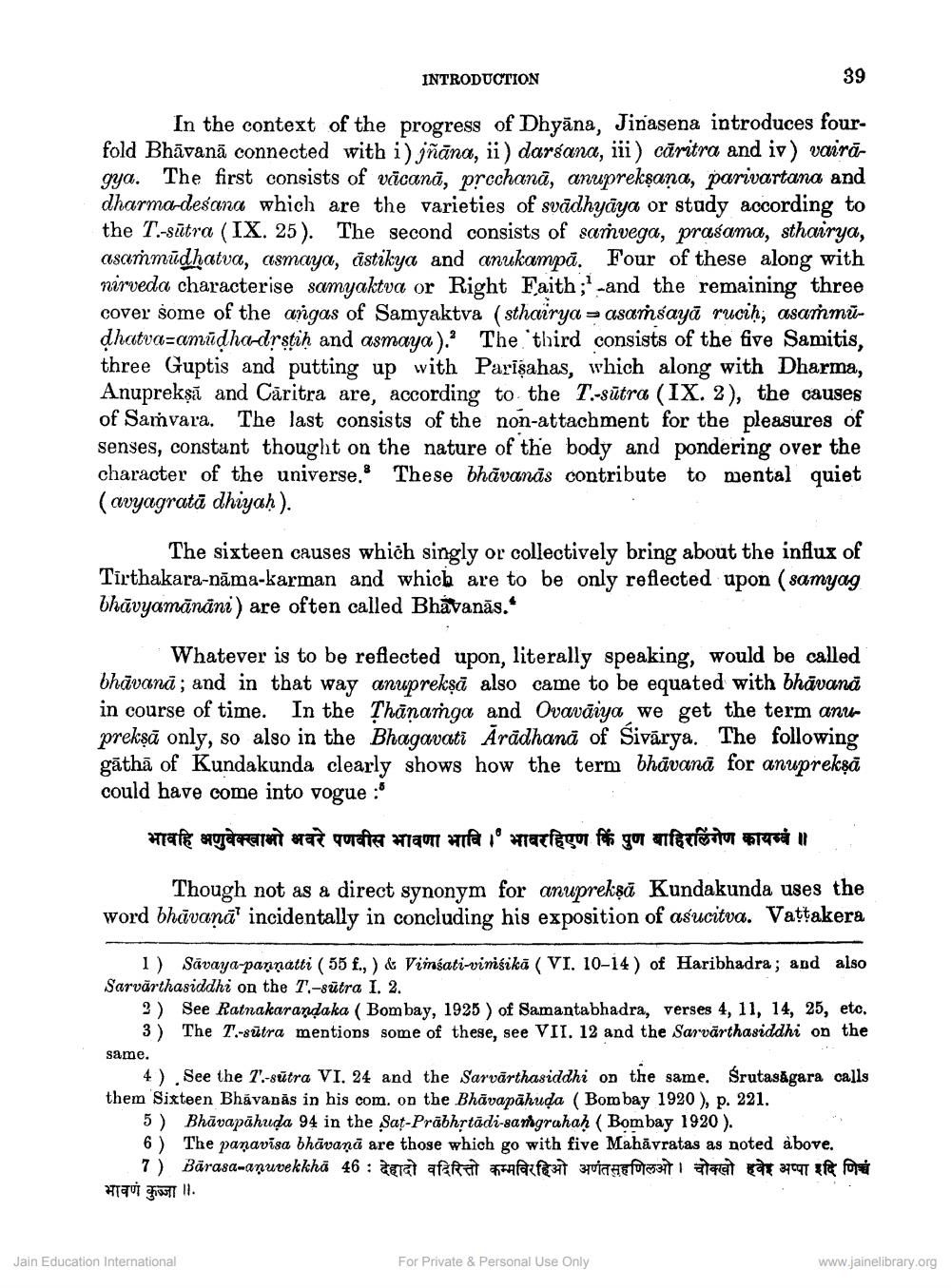________________
INTRODUCTION
39
In the context of the progress of Dhyana, Jinasena introduces fourfold Bhāvanā connected with i) jñāna, ii) darsana, iii) caritra and iv) vairāgya. The first consists of vacană, prcchanā, anuprekşana, parivartana and dharma-desana which are the varieties of svādhyāya or study according to the T.-sutra (IX. 25). The second consists of samvega, prasama, sthairya, asarmūdhatva, asmaya, cistikya and anukampa. Four of these along with nirveda characterise samyaktva or Right Faith;" -and the remaining three cover some of the angas of Samyaktva (sthairya - asaṁsayā rucih; asarmūdhatva=amūdhadrstih and asmaya). The third consists of the five Samitis, three Guptis and putting up with Parīşahas, which along with Dharma, Anupreksă and Caritra are, according to the T-sūtra (IX. 2), the causes of Saṁvara. The last consists of the non-attachment for the pleasures of senses, constant thought on the nature of the body and pondering over the character of the universe. These bhāvanās contribute to mental quiet (avyagrată dhiyah).
The sixteen causes which singly or collectively bring about the influx of Tirthakara-nāma-karman and which are to be only reflected upon (samyag bhāvyamānani) are often called Bhavanās.
Whatever is to be reflected upon, literally speaking, would be called bhāvanā; and in that way anuprekşā also came to be equated with bhāvanā in course of time. In the Thānamga and Ovavāiya we get the term anupreksā only, so also in the Bhagavati Arādhana of Sivārya. The following gāthā of Kundakunda clearly shows how the term bhāvanā for anupreksā could have come into vogue :
भावहि अणुवेक्खाभो भवरे पणवीस भावणा भावि । भावरहिएण किं पुण बाहिरलिंगेण कायम्वं ॥
Though not as a direct synonym for anupreksā Kundakunda uses the word bhāvanā incidentally in concluding his exposition of asucitva. Vattakera
1) Sāvaya-pannatti (55 f., ) & Vimsati-vimśikā ( VI. 10-14 ) of Haribhadra; and also Sarvärthasiddhi on the T.-sütra I. 2.
2) See Ratnakarandaka (Bombay, 1925 ) of Samantabhadra, verses 4, 11, 14, 25, etc.
3) The T'.-sūtra mentions some of these, see VII. 12 and the Sarvārthasiddhi on the same.
4). See the 1'.-sūtra VI. 24 and the Sarvārthasiddhi on the same, rutasågara calls them Sixteen Bhāvanās in his com, on the Bhāvapähuda (Bombay 1920), p. 221.
5) Bhāvapāhuda 94 in the Sat-Prābhrtādi-sangrahah (Bombay 1920 ). 6) The panavisa bhāvanā are those which go with five Mahāvratas as noted above.
7) Bārasa-anuvekkhã 46 : decat afara acfe317 3tvians for 537 et 24T fer foran HITUS II.
Jain Education International
For Private & Personal Use Only
www.jainelibrary.org




